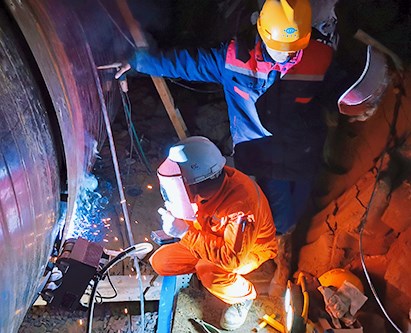Overhead welding is the most difficult welding among the four basic welding positions.
Since the molten pool is located under the weldment, the gravity of the molten metal of the electrode will hinder the excessive droplet, and the molten pool metal will also fall under the action of its own gravity. The larger the molten pool volume, the higher the temperature, and the smaller the surface tension of the molten pool. During overhead welding, the back of the weld is prone to dents, and the weld bead appears on the front side, and the formation of the weld bead is difficult.
Key points of overhead welding operation
1. Be sure to maintain the correct operating posture during overhead welding. The welding point should not be directly above the person. It should be upward and forward, and the welding seam should be biased to the right side of the operator. As shown in the figure, the electrode for overhead welding is clamped The method is the same as vertical welding.
2. Use small diameter welding rod and low current welding. Generally, the welding current of overhead welding is between the welding current of flat welding and vertical welding.
3. Use short arc welding to facilitate droplet transfer.
4. Maintain proper welding rod angle and correct way of transporting the rod, as shown in the figure below.
For butt butt overhead welding without beveling, the linear strip should be used when the gap is small, and the reciprocating linear strip should be used when the gap is large.
When multi-layer welding is adopted for open-groove butt butt-overhead welding, the first-layer welding seam selects linear or straight-line transport mode according to the size of the groove gap. The rest of each layer adopts crescent or zigzag movement.
Multi-layer and multi-pass welding should adopt linear transport strips.
For T-shaped joints with smaller welding foot sizes, single-layer welding is used, and the straight-line transport method is used. When the size of the welding foot is large, adopt multi-layer welding or multi-layer multi-pass welding. The first layer should be transported in a straight line, and the other layers can be transported in an oblique ring or triangle.
5. When the temperature of the molten pool is too high, the arc can be slightly raised to slightly lower the temperature of the molten pool.
6. During overhead welding, due to the gravity of the welding torch and the cable, the operator is prone to instability in holding the gun, so sometimes it is necessary to hold the gun with both hands for welding.
7. When transporting the rod in an oblique circle, you should consciously make the electrode head point to the upper plate first, so that the molten droplet merges with the upper plate first. Due to the effect of the transport rod, part of the molten metal will naturally be dragged onto the steel plate on the facade. A uniform fusion can be obtained in two passes.
8. The short arc welding of 0.5~1mm should be maintained during the straight line transportation. Do not drag the electrode head on the welding seam to prevent the narrow and convex welding seam.
9. Maintain the correct welding rod angle and uniform welding speed, maintain a short arc, and the upward feeding speed must be consistent with the welding rod burning speed.
10. When the surface of the molten pool seen during welding is flat or slightly concave, it is best. When the temperature is high, the surface of the molten pool will bulge or protrude. In severe cases, weld bumps will appear. The solution is to speed up the process. The speed of the front swing and shorten the residence time on both sides, if necessary, reduce the welding current.
11. In the case of multi-pass welding, in addition to the bottoming and careful slag removal, do not remove the slag in each pass on the cover surface. You can weld in the order shown in the following figure, and the center of the electrode of the next weld is pointing to 1/3 or 1/2 of the previous weld. the edge of. During operation, the electrode angle must be correct, the speed must be uniform, and the arc must be short.
12. Welding and continuation are prone to mixing slag and molten metal during the preheating process. At this time, the angle between the welding rod and the upper plate should be reduced to increase the arc blowing force, and the arc must not be extinguished. If the starting point is too high or there is a weld bead, it should be cut off with an arc.
Post time: Jan-28-2021

